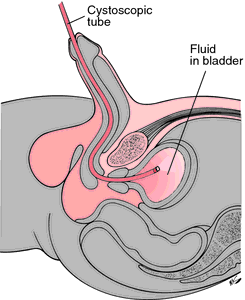Medical term:
prostatography
Cystoscopy
Definition
Cystoscopy (cystourethroscopy) is a diagnostic procedure that is used to look at the bladder (lower urinary tract), collect urine samples, and examine the prostate gland. Performed with an optic instrument known as a cystoscope (urethroscope), this instrument uses a lighted tip for guidance to aid in diagnosing urinary tract disease and prostate disease. Performed by a urologist, this surgical test also enables biopsies to be taken or small stones to be removed by way of a hollow channel in the cystoscope.
Purpose
Categorized as an endoscopic procedure, cystoscopy is used by urologists to examine the entire bladder lining and take biopsies of any areas that look questionable. This test is not used on a routine basis, but may benefit the urologist who is needing further information about a patient who displays the following symptoms or diagnosis:
- blood in the urine (also known as hematuria)
- incontinence or the inabililty to control urination
- a urinary tract infection
- a urinary tract which display signs of congenital abnormalities
- tumors located in the bladder
- the presence of bladder or kidney stones
- a stiffness or strained feeling of the urethra or ureters
- symptoms of an enlarged prostate
Blood and urine studies, in addition to x rays of the kidneys, ureters and bladder may all occur before a cystoscopy. At the time of surgery, a retrograde pyelogram may also be performed. Additional blood studies may be needed immediately following surgery.
Precautions
While the cystoscopy procedure is commonly relied upon to gather additional diagnostic information, it is an invasive surgical technique that may involve risks for certain patients. Those who are extremely overweight (obese), smoke, are recovering from a recent illness, or are treating a chronic condition may face additional risks from surgery.
Surgical risk also increases in patients who are currently using certain drugs including antihypertensives; muscle relaxants; tranquilizers; sleep inducers; insulin; sedatives; beta blockers; or cortisone. Those who use mind-altering drugs also put themselves at increased risk of complications during surgery. The following mind-altering drugs should be avoided: narcotics; psychedelics; hallucinogens; marijuana; sedatives; hypnotics; or cocaine.
Description
Depending on the type of information needed from a cystoscopy, the procedure typically takes  10-40 minutes to complete. The patient will be asked to urinate before surgery which allows an accurate measurement of the remaining urine in the bladder. A well-lubricated cystoscope is inserted through the urethra into the bladder where a urine sample is taken. Fluid is then pushed in to inflate the bladder and allow the urologist to examine the entire bladder wall.
10-40 minutes to complete. The patient will be asked to urinate before surgery which allows an accurate measurement of the remaining urine in the bladder. A well-lubricated cystoscope is inserted through the urethra into the bladder where a urine sample is taken. Fluid is then pushed in to inflate the bladder and allow the urologist to examine the entire bladder wall.

Cystoscopy is a diagnostic procedure which is used to view the bladder, collect urine samples, and examine the prostate gland. This procedure also enables biopsies to be taken. The primary instrument used in cystoscopy is the cystoscope, a tube which is inserted through the penis into the urethra, and ultimately into the bladder.
(Illustration by Electronic Illustrators Group.)
During an examination, the urologist may take the following steps: remove either bladder or kidney stones; gather tissue samples; and treat any suspicious lesions. In order to perform x-ray studies (retrograde pyelogram), a harmless dye is injected into the ureters by way of a catheter that is passed through the previously placed cystoscope. After completion of all needed tests, the cystoscope is removed.
Preparation
As procedure that can be completed in a hospital, doctor's office, or outpatient surgical facility, an injection of spinal or general anesthesia may be used prior to a cystoscopy. While this test is typically performed on an outpatient basis, a patient may require up to three days of recovery in the hospital.
Aftercare
Patients who have undergone a cystoscopy will be instructed to follow these steps to ensure a quick recovery:
- due to soreness or discomfort that may occur in the urethra, especially while urinating, several warm baths a day are recommended to relieve any pain

A cystoscope helps the doctor examine the urethra, bladder, and prostate.
(Illustration by Argosy Inc.)
- allow four days for recovery
- blood may appear in the urine-this is common, and soon clears up in one to two days following the procedure
- avoid strenuous exercise for a minimum of two weeks following surgery
- sexual relations may continue when the urologist determines that healing is complete
- wait at least two days after surgery before driving
Patients may also be prescribed pain relievers and antibiotics following surgery. Minor pain may also be treated with over-the-counter, non-prescription drugs such as acetaminophen.
Risks
As with any surgical procedure, there are some risks involved with a cystoscopy. Complications may include: profuse bleeding; a damaged urethra; a perforated bladder; a urinary tract infection; or an injured penis.
Patients should also contact their physician if they experience any of the following symptoms following surgery: pain, redness, swelling, drainage, or bleeding from the surgical site; signs of infection that may include headache, muscle aches, dizziness or an overall ill feeling and fever; nausea or vomiting; strenuous or painful urination; or symptoms that may result as side-effects from the medication.
Normal results
A successful cystoscopy includes a thorough examination of the bladder and collection of urine samples for cultures. If no abnormalities are seen, the results are indicated as normal.
Key terms
Endoscopy — Examination of body organs or cavities through the use of an endoscope (a lighted optical instrument used to see inside body cavities), such as a cystoscope used to complete a cystoscopy.
Retrograde pyelogram — A pyelography or x-ray technique where radiopaque dye is injected into the kidneys from below, by way of the ureters, allowing further examination of the kidneys.
Ureter — The tube that carries urine from the kidney to the bladder, with each kidney having one ureter.
Urethra — A passageway from the bladder to the outside for the discharge of urine. In the female this canal lies between the vagina and clitoris; in the male the urethra travels through the penis, opening at the tip.
Abnormal results
Cystoscopy allows the urologist to detect inflammation of the bladder lining, prostatic enlargement, or tumors. If these are seen, further evaluation or biopsies may be needed in addition to the removal of some tumors.
Resources
Organizations
American Cancer Society. 1599 Clifton Rd., NE, Atlanta, GA 30329-4251. (800) 227-2345. http://www.cancer.org.
Gale Encyclopedia of Medicine. Copyright 2008 The Gale Group, Inc. All rights reserved.
cystoscopy
[sis-tos´kah-pe]examination of the bladder by means of a cystoscope, a hollow metal tube that is introduced into the urinary meatus and passed through the urethra and into the bladder. At the end of the cystoscope is an electric bulb that illuminates the bladder interior. By means of special lenses and mirrors the bladder mucosa is examined for inflammation, calculi, or tumors.
A catheter can be passed through the cystoscope into the bladder or, if necessary, beyond, into the ureters and kidneys. In this way samples of urine can be obtained for diagnostic purposes. Also, radiopaque fluids can be injected into the bladder or ureters for x-rays of the urinary tract (see also pyelography).
A catheter can be passed through the cystoscope into the bladder or, if necessary, beyond, into the ureters and kidneys. In this way samples of urine can be obtained for diagnostic purposes. Also, radiopaque fluids can be injected into the bladder or ureters for x-rays of the urinary tract (see also pyelography).

Cystoscopy: examination of the male bladder. The cystoscope is passed through the urethra into the bladder. Although shown here as a flexible scope, usually the scope is rigid. Through the scope fluid is instilled to maintain bladder distention. From Beare and Myers, 1998.
Patient Care. Prior to the procedure the patient should be given an adequate explanation of its purpose and expected outcome, and of the need for proper preparation. Because the full cooperation of the patient is of crucial importance to a successful test, it is essential that the patient be told what is expected of him or her when the procedure is done under local anesthesia. During the procedure, if the patient is awake, the nurse or other attendant should be alert for indications of sudden pain, which could signify perforation of the urethra or other structures. Another complication that can occur in patients with a history of heart disease is cardiac arrhythmia.
The plan of care following cystoscopy should include observation of the amount and character of the urine. Some slight coloration from blood should be expected, but any frank bleeding and passing of clots should be reported to the surgeon. Other problems likely to require nursing intervention are discomfort from bladder spasms, back pain, a feeling of fullness and burning in the bladder region, and possible urinary retention. Nursing measures would include warm sitz baths, relaxation techniques to promote rest and provide relief from pain, and administration of prescribed medications.
If chilling and fever occur and do not respond to attempts to provide warmth and to increased fluid intake, there could be an infection in the urinary tract requiring antibacterial therapy.
The plan of care following cystoscopy should include observation of the amount and character of the urine. Some slight coloration from blood should be expected, but any frank bleeding and passing of clots should be reported to the surgeon. Other problems likely to require nursing intervention are discomfort from bladder spasms, back pain, a feeling of fullness and burning in the bladder region, and possible urinary retention. Nursing measures would include warm sitz baths, relaxation techniques to promote rest and provide relief from pain, and administration of prescribed medications.
If chilling and fever occur and do not respond to attempts to provide warmth and to increased fluid intake, there could be an infection in the urinary tract requiring antibacterial therapy.
Miller-Keane Encyclopedia and Dictionary of Medicine, Nursing, and Allied Health, Seventh Edition. © 2003 by Saunders, an imprint of Elsevier, Inc. All rights reserved.
cys·tos·co·py
(sis-tos'kŏ-pē),The inspection of the interior of the bladder by means of a cystoscope.
Farlex Partner Medical Dictionary © Farlex 2012
cystoscopy
Urology The use of a cystoscope or urethroscope with a fiberoptic light source, to directly visualize the urethra and bladder, and detect lower urinary tract diseaseMcGraw-Hill Concise Dictionary of Modern Medicine. © 2002 by The McGraw-Hill Companies, Inc.
cys·tos·co·py
(sis-tos'kŏ-pē)The inspection of the interior of the bladder by means of a cystoscope.
Medical Dictionary for the Health Professions and Nursing © Farlex 2012
cystoscopy
Examination of the inside the bladder with an optical instrument called a cystoscope, passed along the urethra. This requires general anaesthesia in the male but can be done under local anaesthesia in the female. Cystoscopy facilitates the diagnosis of conditions such as infections, polyps, cancers and stones in the bladder, and allows biopsies to be taken and local treatment by cautery, laser and other means to be given. It also makes it possible to pass fine catheters up the tubes leading to the kidneys (the ureters) through which a substance opaque to X-rays can be injected for X-ray studies (retrograde pyelography).Collins Dictionary of Medicine © Robert M. Youngson 2004, 2005
Latest Searches:
verticosubmental - verticomental - verticis - Verticillium - verticillate - verticillata - verticil - verticellatus - verticalis - vertical - vertex - verteporfin - vertebrosternal - vertebrosacral - vertebropleural - vertebroplasty - vertebropelvic - vertebromammary - vertebroiliac - vertebrogenic -
- Service manuals - MBI Corp